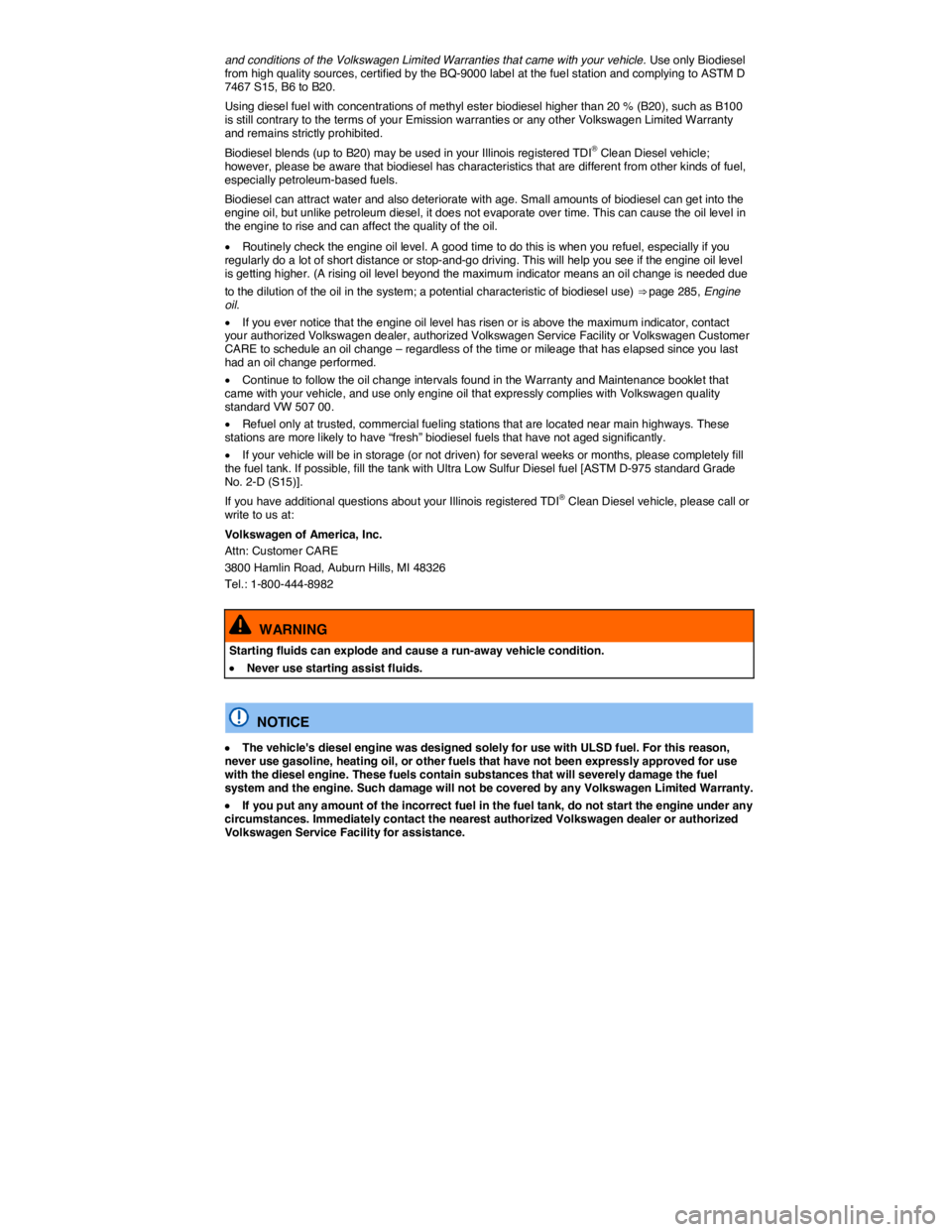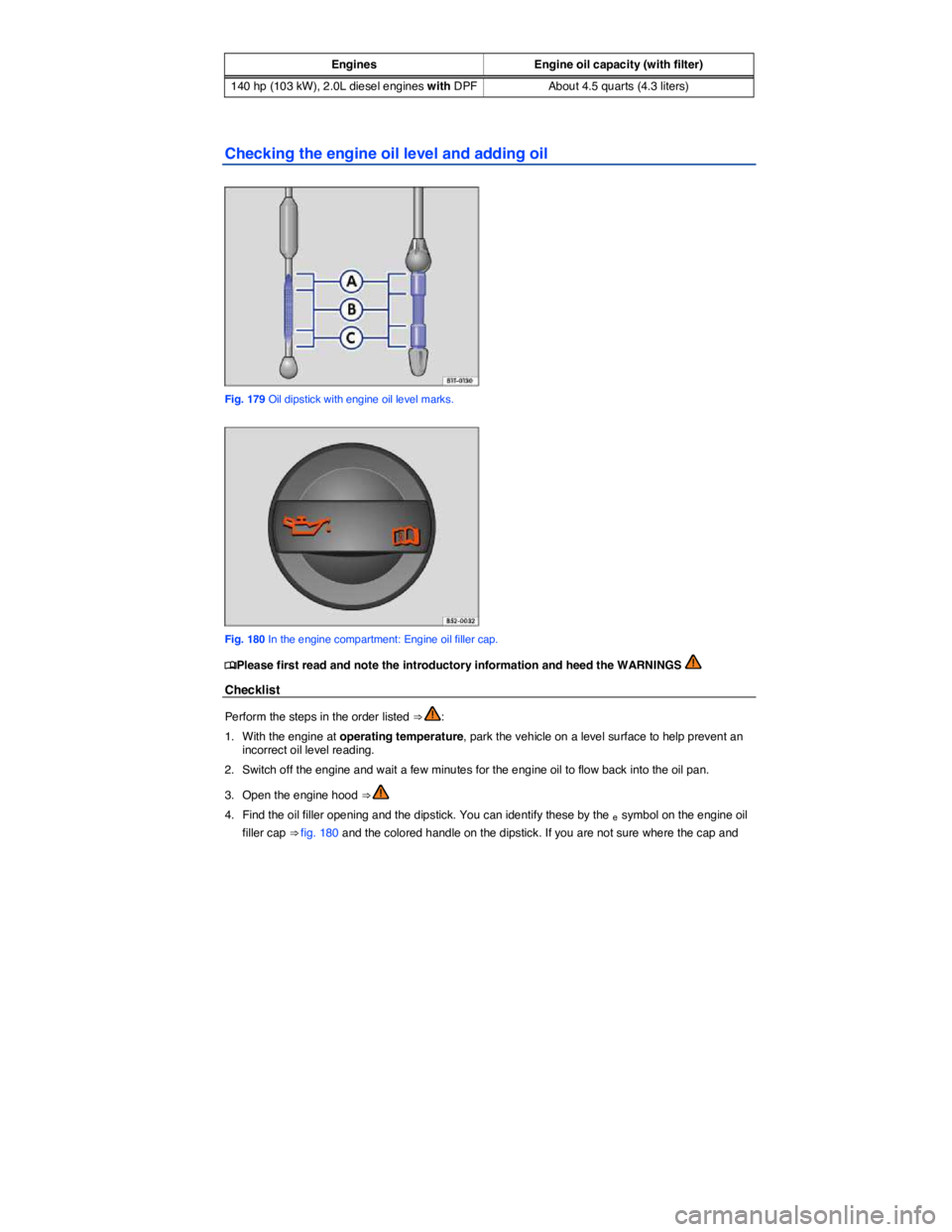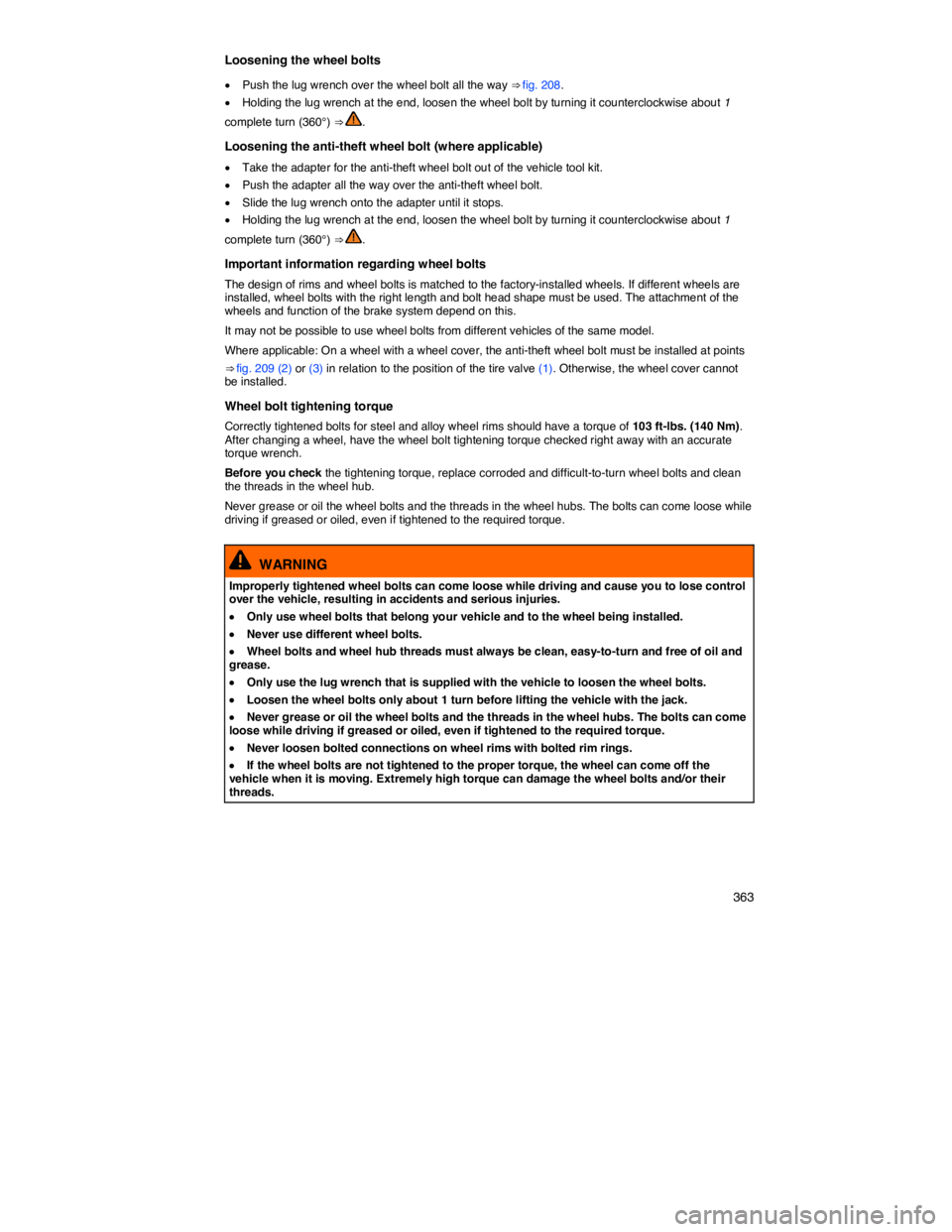2008 VOLKSWAGEN PASSAT check oil
[x] Cancel search: check oilPage 272 of 392

and conditions of the Volkswagen Limited Warranties that came with your vehicle. Use only Biodiesel from high quality sources, certified by the BQ-9000 label at the fuel station and complying to ASTM D 7467 S15, B6 to B20.
Using diesel fuel with concentrations of methyl ester biodiesel higher than 20 % (B20), such as B100 is still contrary to the terms of your Emission warranties or any other Volkswagen Limited Warranty and remains strictly prohibited.
Biodiesel blends (up to B20) may be used in your Illinois registered TDI® Clean Diesel vehicle; however, please be aware that biodiesel has characteristics that are different from other kinds of fuel, especially petroleum-based fuels.
Biodiesel can attract water and also deteriorate with age. Small amounts of biodiesel can get into the engine oil, but unlike petroleum diesel, it does not evaporate over time. This can cause the oil level in the engine to rise and can affect the quality of the oil.
�x Routinely check the engine oil level. A good time to do this is when you refuel, especially if you regularly do a lot of short distance or stop-and-go driving. This will help you see if the engine oil level is getting higher. (A rising oil level beyond the maximum indicator means an oil change is needed due
to the dilution of the oil in the system; a potential characteristic of biodiesel use) ⇒ page 285, Engine oil.
�x If you ever notice that the engine oil level has risen or is above the maximum indicator, contact your authorized Volkswagen dealer, authorized Volkswagen Service Facility or Volkswagen Customer CARE to schedule an oil change – regardless of the time or mileage that has elapsed since you last had an oil change performed.
�x Continue to follow the oil change intervals found in the Warranty and Maintenance booklet that came with your vehicle, and use only engine oil that expressly complies with Volkswagen quality standard VW 507 00.
�x Refuel only at trusted, commercial fueling stations that are located near main highways. These stations are more likely to have “fresh” biodiesel fuels that have not aged significantly.
�x If your vehicle will be in storage (or not driven) for several weeks or months, please completely fill the fuel tank. If possible, fill the tank with Ultra Low Sulfur Diesel fuel [ASTM D-975 standard Grade No. 2-D (S15)].
If you have additional questions about your Illinois registered TDI® Clean Diesel vehicle, please call or write to us at:
Volkswagen of America, Inc.
Attn: Customer CARE
3800 Hamlin Road, Auburn Hills, MI 48326
Tel.: 1-800-444-8982
WARNING
Starting fluids can explode and cause a run-away vehicle condition.
�x Never use starting assist fluids.
NOTICE
�x The vehicle's diesel engine was designed solely for use with ULSD fuel. For this reason, never use gasoline, heating oil, or other fuels that have not been expressly approved for use with the diesel engine. These fuels contain substances that will severely damage the fuel system and the engine. Such damage will not be covered by any Volkswagen Limited Warranty.
�x If you put any amount of the incorrect fuel in the fuel tank, do not start the engine under any circumstances. Immediately contact the nearest authorized Volkswagen dealer or authorized Volkswagen Service Facility for assistance.
Page 282 of 392

NOTICE
When changing or topping off fluids, make sure that you pour the fluids into the correct reservoirs. Adding the wrong type of operating fluids will cause serious malfunctions and engine damage.
Fluid leaks and spills are harmful to the environment. Regularly check the ground underneath your vehicle for this reason. If you find spots of oil or other fluids, have your vehicle checked by your authorized Volkswagen dealer or authorized Volkswagen Service Facility. Dispose of leaked operating fluids properly.
Warning light
�
Page 288 of 392

Engines Engine oil capacity (with filter)
140 hp (103 kW), 2.0L diesel engines with DPFAbout 4.5 quarts (4.3 liters)
Checking the engine oil level and adding oil
Fig. 179 Oil dipstick with engine oil level marks.
Fig. 180 In the engine compartment: Engine oil filler cap.
�
Page 318 of 392

Removing stains
When treating stains, it may be necessary to clean entire surface and not just the stain itself. This is especially true if the entire surface has become dirty from normal use. Otherwise, the area that is treated may be lighter than the untreated area. If you have questions or concerns, consult a professional cleaner.
Type of stain Recommended cleaning for fabric and upholstery
Water-based stains, such as coffee or fruit juice. – Moisten a sponge with water and rub the stain gently with a circular motion. – Wipe dry with an absorbent cloth.
Persistent stains, such as chocolate or make-up. – Use only Volkswagen-approved cleaning products. – If necessary, have the fabric or upholstery professionally cleaned.
Grease-based stains, such as oil, lipstick, etc. – Use only Volkswagen-approved cleaning products. – If necessary, have the fabric or upholstery professionally cleaned.
WARNING
If there is a malfunction in the airbag system, the airbag may not deploy correctly or at all, or it may deploy unexpectedly. This could cause fatal injuries.
�x Have the airbag system inspected immediately by your authorized Volkswagen dealer or authorized Volkswagen Service Facility.
NOTICE
If the upholstery on power seats, heated seats, or seats with airbag components is wet, electrical components and the vehicle electrical system could be damaged.
�x If the seating surface becomes soaked, have it dried and the system components checked immediately by an authorized Volkswagen dealer or authorized Volkswagen Service Facility.
�x Do not use steam cleaners because the steam could cause the dirt to penetrate deeper into the fabric and make it impossible to remove.
�x Pressure washers and cooling sprays can damage the upholstery.
NOTICE
�x Clean only the carpet and floor mats with brushes. Other textile surfaces can be damaged by brushes.
�x If detergent pastes or mild detergent solutions are applied with a damp cloth or sponge, the surfactants in the detergent may cause visible lines to form at the edges of the area where the detergent was applied. These lines are generally difficult or impossible to remove.
NOTICE
�x Do not soak Alcantara®.
�x Do not treat Alcantara® with leather care products, solvents, floor wax, shoe polish, stain remover or similar products.
�x Do not use brushes for damp cleaning, because they can damage upholstery surfaces.
�x Do not use a steam cleaner, because dirt will penetrate deeper into the fabric.
Page 361 of 392

363
Loosening the wheel bolts
�x Push the lug wrench over the wheel bolt all the way ⇒ fig. 208.
�x Holding the lug wrench at the end, loosen the wheel bolt by turning it counterclockwise about 1
complete turn (360°) ⇒ .
Loosening the anti-theft wheel bolt (where applicable)
�x Take the adapter for the anti-theft wheel bolt out of the vehicle tool kit.
�x Push the adapter all the way over the anti-theft wheel bolt.
�x Slide the lug wrench onto the adapter until it stops.
�x Holding the lug wrench at the end, loosen the wheel bolt by turning it counterclockwise about 1
complete turn (360°) ⇒ .
Important information regarding wheel bolts
The design of rims and wheel bolts is matched to the factory-installed wheels. If different wheels are installed, wheel bolts with the right length and bolt head shape must be used. The attachment of the wheels and function of the brake system depend on this.
It may not be possible to use wheel bolts from different vehicles of the same model.
Where applicable: On a wheel with a wheel cover, the anti-theft wheel bolt must be installed at points
⇒ fig. 209 (2) or (3) in relation to the position of the tire valve (1). Otherwise, the wheel cover cannot be installed.
Wheel bolt tightening torque
Correctly tightened bolts for steel and alloy wheel rims should have a torque of 103 ft-lbs. (140 Nm). After changing a wheel, have the wheel bolt tightening torque checked right away with an accurate torque wrench.
Before you check the tightening torque, replace corroded and difficult-to-turn wheel bolts and clean the threads in the wheel hub.
Never grease or oil the wheel bolts and the threads in the wheel hubs. The bolts can come loose while driving if greased or oiled, even if tightened to the required torque.
WARNING
Improperly tightened wheel bolts can come loose while driving and cause you to lose control over the vehicle, resulting in accidents and serious injuries.
�x Only use wheel bolts that belong your vehicle and to the wheel being installed.
�x Never use different wheel bolts.
�x Wheel bolts and wheel hub threads must always be clean, easy-to-turn and free of oil and grease.
�x Only use the lug wrench that is supplied with the vehicle to loosen the wheel bolts.
�x Loosen the wheel bolts only about 1 turn before lifting the vehicle with the jack.
�x Never grease or oil the wheel bolts and the threads in the wheel hubs. The bolts can come loose while driving if greased or oiled, even if tightened to the required torque.
�x Never loosen bolted connections on wheel rims with bolted rim rings.
�x If the wheel bolts are not tightened to the proper torque, the wheel can come off the vehicle when it is moving. Extremely high torque can damage the wheel bolts and/or their threads.